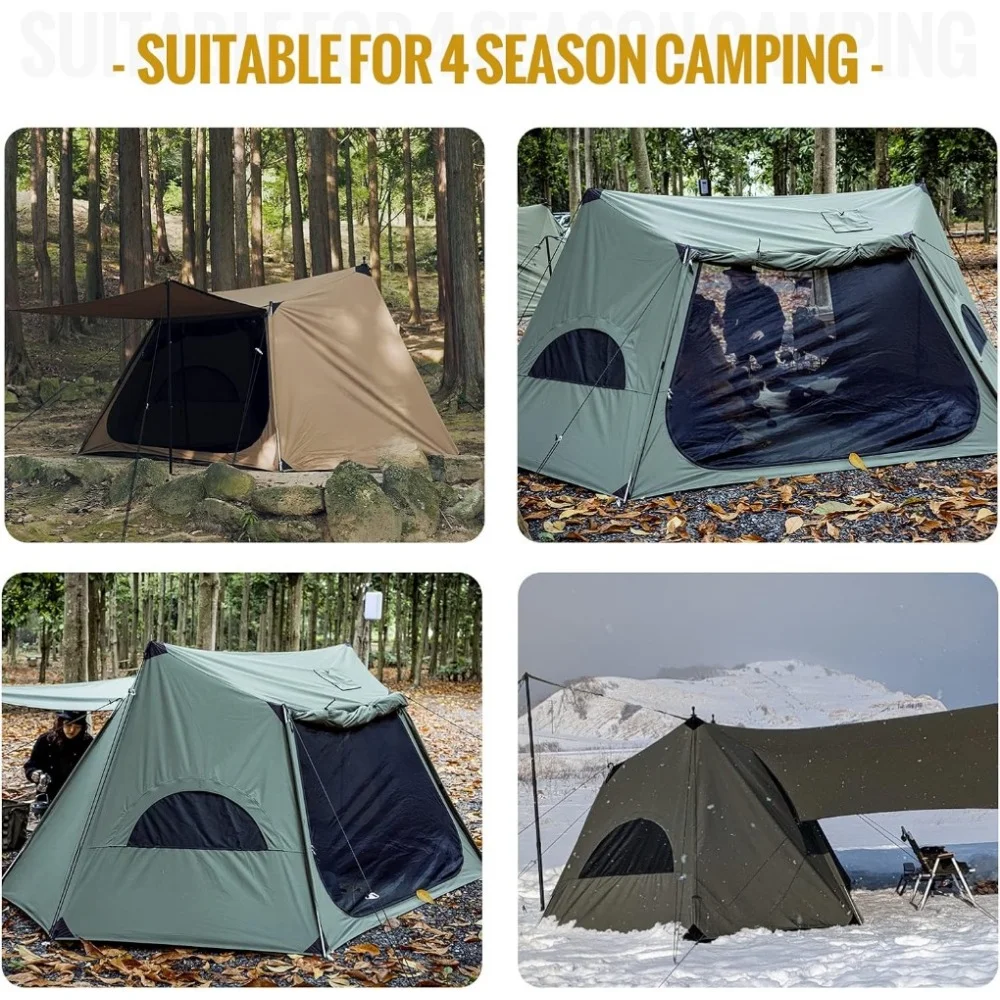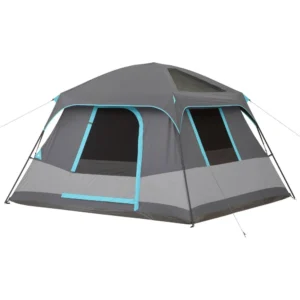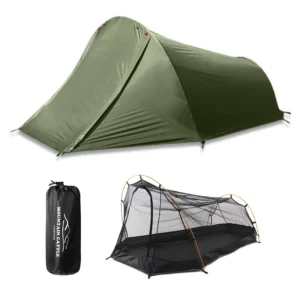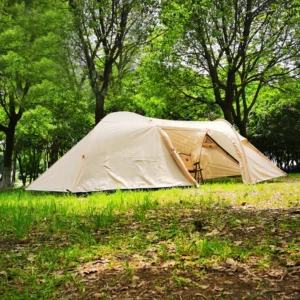The Superior Nature of Canvas Material for Extreme Outdoor Conditions
When it comes to facing Mother Nature’s most challenging conditions, not all camping shelters are created equal. Rugged camping – characterized by extreme weather, remote locations, extended stays, and challenging environments – demands equipment that can withstand intense punishment while keeping you safe and comfortable.
Canvas stands apart as the premium material for these demanding scenarios. Unlike modern synthetic fabrics, traditional canvas offers a unique combination of durability and livability that makes it particularly well-suited for harsh conditions. The natural cotton fibers in canvas tents for rugged camping provide several distinct advantages:
- Self-healing properties: When canvas gets wet, the cotton fibers naturally swell and expand, effectively sealing small holes and preventing leaks – a property synthetic materials simply cannot replicate.
- Superior insulation: Canvas provides significantly better thermal regulation, with R-values typically 20-30% higher than comparable synthetic tents, keeping you warmer in winter and cooler in summer.
- Natural breathability: The fabric allows moisture vapor to escape while preventing water droplets from entering, dramatically reducing condensation issues common in synthetic shelters.
- Sound dampening: Canvas absorbs rather than amplifies rain and wind noise, creating a quieter, more restful environment during storms.
- Impressive longevity: With proper care, quality canvas shelters can last decades rather than the 5-7 year lifespan typical of synthetic alternatives.
The science behind canvas performance is compelling. The natural fibers create millions of tiny air pockets that provide exceptional insulation properties while still allowing molecular water vapor to pass through. This creates a comfortable internal environment even in extreme conditions, unlike the sauna-like condensation common in synthetic shelters during cold-weather camping.
When comparing canvas to nylon tents in wilderness settings, the weight penalty of canvas becomes a worthwhile trade-off for its durability and comfort benefits. While synthetics excel for ultralight backpacking, canvas proves superior for base camping, extended stays, and situations where reliability trumps minimalism.
For those preparing to face harsh environments, exploring quality canvas camping tent options ensures you’ll have shelter you can truly depend on when conditions deteriorate. The initial investment in canvas typically pays dividends through years of reliable service in conditions that would quickly destroy lesser materials.
Essential Features of Rugged Canvas Shelters
Understanding the specific components that contribute to a canvas shelter’s performance in extreme conditions helps you make informed decisions before venturing into challenging environments. Not all canvas shelters are built with the same specifications or quality standards.
Canvas Material Quality and Weight
The foundation of any durable canvas shelter starts with the fabric itself. Canvas quality is primarily measured in ounces per square yard (oz/yd²), with heavier weights indicating more robust material:
- 10-12 oz canvas: Standard weight, suitable for most camping conditions
- 13-15 oz canvas: Heavy-duty material ideal for extended use in challenging environments
- 16+ oz canvas: Expedition-grade material for extreme conditions and prolonged deployment
Beyond mere weight, the cotton duck fabric quality plays a crucial role. Look for tightly woven canvas with consistent thread counts that provide the ideal balance of strength and breathability. Many heavy-duty canvas shelters use double-fill construction, where two threads are woven as one to create a denser, stronger fabric.
Critical Protective Treatments
Raw canvas by itself isn’t suitable for extreme conditions. What transforms basic canvas into a weather-resistant shelter are specialized treatments:
- Waterproofing treatments: Typically silicone, paraffin, or polyurethane-based to prevent water penetration
- Fire retardants: Essential treatments that prevent canvas from readily igniting, especially important when using stoves
- UV inhibitors: Protect the fabric from sun degradation, particularly important for high-altitude camping
- Anti-mildew compounds: Prevent fungal growth during extended wet conditions or storage
The most durable canvas shelters combine multiple treatments without compromising the natural properties of the material. Look for shelters that disclose their specific treatment protocols rather than using vague marketing terminology.
Structural Reinforcements
A canvas shelter’s ability to withstand extreme stress depends on strategic reinforcement at key points:
- Double or triple-stitched seams: Using marine-grade thread that resists UV degradation and moisture damage
- Reinforced corners and stress points: Often with additional layers of heavy-duty material
- Bar-tack stitching: At all critical connection points to prevent tearing under load
- Heavy-duty grommets and D-rings: Made from brass or stainless steel rather than aluminum or plastic
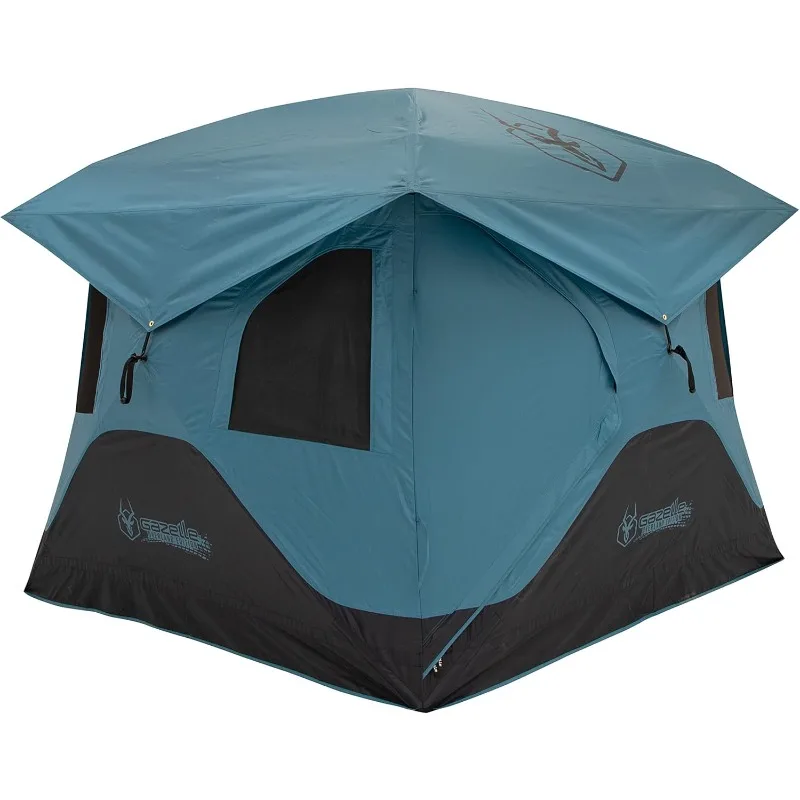
Frame Systems and Support Structures
The skeleton of a rugged canvas shelter must be equally robust as its skin:
- Frame materials: Aircraft-grade aluminum or galvanized steel poles with wall thicknesses sufficient for high winds and snow loads
- Connection points: Reinforced pole sleeves or attachment points that distribute stress evenly
- Guy-out systems: Multiple heavy-duty guy points with reflective, high-tensile cordage
- Base structures: Robust floor systems or ground anchoring methods appropriate for challenging terrain
For truly extreme conditions, heavy-duty 4-season tents combine optimized frame systems with quality canvas to create shelters capable of withstanding formidable environmental challenges.
Weather-Specific Features
Depending on your intended environment, specialized features become essential:
- Stove jacks: Heat-resistant portals allowing safe use of wood stoves in cold weather
- Snow skirts: Prevent drafts and blowing snow from entering underneath
- Oversized vestibules: Provide transition spaces for gear storage and weather protection
- Ventilation systems: Strategically placed screened vents with waterproof covers for moisture management
- Heavy-duty zippers: YKK or similar quality with storm flaps and anti-snag designs
Remember that each of these features adds weight and complexity but pays dividends when conditions deteriorate to the point where lesser shelters would fail.
Structural Designs for Maximum Stability in Extreme Conditions
The architectural design of a canvas shelter fundamentally determines how it will perform when faced with extreme environmental challenges. Different structural approaches offer varying advantages depending on the specific conditions you anticipate encountering.
Wall Tent Designs
Wall tents represent the gold standard for extended stays in demanding environments. Their boxy, cabin-like design maximizes interior space while providing excellent stability characteristics:
- Vertical walls create maximum usable interior space and shed snow effectively
- Ridge pole designs distribute weight evenly and resist collapsing under snow loads
- Multiple interior frame points prevent billowing and maintain tension during high winds
- Rectangular footprint allows for optimal interior organization including cots and stoves
When properly set up with all guy lines deployed, quality wall tents have been proven to withstand sustained winds of 50+ mph and snow loads exceeding 100 pounds. Their canvas shelter durability in rough weather is unmatched for base camp scenarios.
Bell Tent Configurations
The conical design of bell tents offers a different but equally effective approach to stability:
- Central pole design creates a naturally wind-shedding profile similar to a teepee
- 360-degree guy line system distributes tension evenly around the entire perimeter
- Circular footprint eliminates corner stress points present in rectangular designs
- Adjustable ventilation cap at the peak allows heat and moisture management
Bell tents excel in windy conditions where their circular design naturally deflects gusts rather than creating flat surfaces that catch the wind. Many modern bell tents incorporate additional wall support systems to prevent sidewall collapse during heavy precipitation.
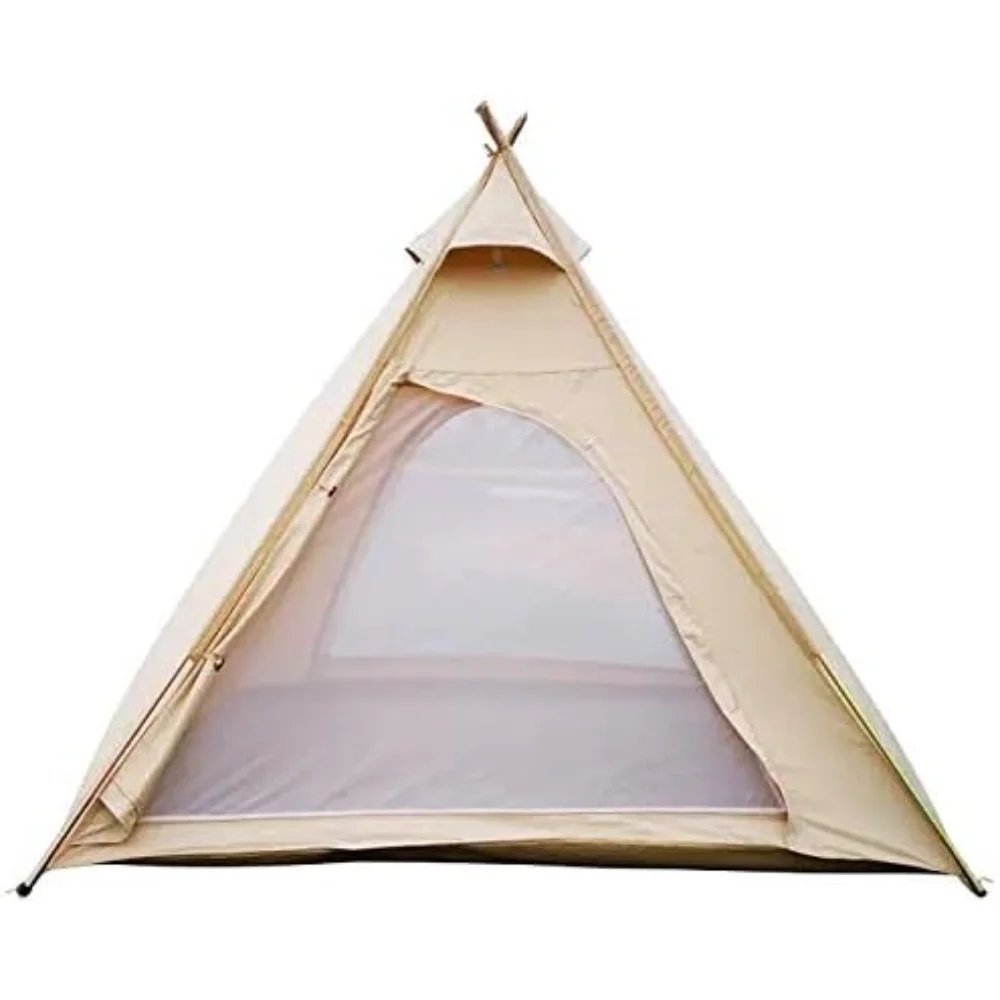
A-Frame and Modified A-Frame Systems
Traditional A-frame designs have evolved into sophisticated shelter systems that balance simplicity with remarkable stability:
- Steep wall angles effectively shed rain and snow without pooling
- Triangulated support structure provides inherent strength with minimal materials
- Low profile options reduce wind exposure in extreme conditions
- Ridge reinforcement systems prevent sagging under heavy precipitation
Modern modifications to the classic A-frame often include extended vestibules and near-vertical sidewalls that increase interior space while maintaining the fundamental stability benefits of the design.
For those facing truly challenging winter conditions, winter camping tents designed specifically for extreme weather combine optimal structural engineering with premium materials.
Anchoring Systems for Different Terrains
A shelter’s inherent structural integrity is only as good as its connection to the ground. Advanced anchoring systems are crucial in rugged environments:
- Snow and sand anchors: Specialized wide-profile stakes or buried deadman anchors
- Rock adaptation systems: Tie points designed to work with natural anchoring objects
- Frozen ground solutions: Screw-type anchors or self-drilling designs
- Multiple-point security: Redundant anchoring patterns that prevent catastrophic failure
Remember that a properly guyed out canvas shelter with sufficient anchoring can survive conditions that would destroy lesser setups. Always carry anchoring options appropriate for the terrain you’ll encounter.
Top Canvas Shelters for Different Rugged Environments
Selecting the right canvas shelter depends on matching specific design features to the environmental challenges you’ll face. The following recommendations are categorized by environmental challenge, helping you identify options best suited for your particular adventure needs.
Extreme Cold Weather Performers
When temperatures plummet and snow accumulates, these canvas shelters excel:
| Model Type | Best Features | Weight | Capacity | Price Range |
|---|---|---|---|---|
| Hot Tent with Stove Jack | 13oz canvas, 5” stove jack, snow skirt | 32-45 lbs | 2-4 person | $$$-$$$$ |
| Insulated Wall Tent | Double-layer canvas, insulated floor | 55-70 lbs | 4-6 person | $$$$-$$$$$ |
| Arctic Expedition Bell | Storm tie-down points, reinforced poles | 35-50 lbs | 3-5 person | $$$-$$$$ |
These shelters feature oversized stove jacks compatible with most wood stoves, reinforced snow-load bearing frames, and ventilation systems specifically designed to prevent condensation freeze-up issues common in extreme cold.
High-Wind Environment Specialists
For exposed ridgelines, coastal areas, or anywhere else powerful winds pose a threat:
| Model Type | Best Features | Weight | Capacity | Price Range |
|---|---|---|---|---|
| Low-Profile Alpine | Aerodynamic design, reinforced guy points | 28-40 lbs | 2-3 person | $$$-$$$$ |
| Heavy-Duty Geodesic | Multi-point frame contact, stabilized walls | 45-60 lbs | 3-4 person | $$$$-$$$$$ |
| Wind-Shedding Bell | Double center pole, 24 guy-out points | 30-45 lbs | 2-4 person | $$$-$$$$ |
Wind-resistant designs prioritize aerodynamic profiles, redundant guy-line systems, and frames specifically engineered to flex without breaking under gusty conditions. For those specifically facing mountain conditions, mountaineering tents offer specialized designs for alpine challenges.
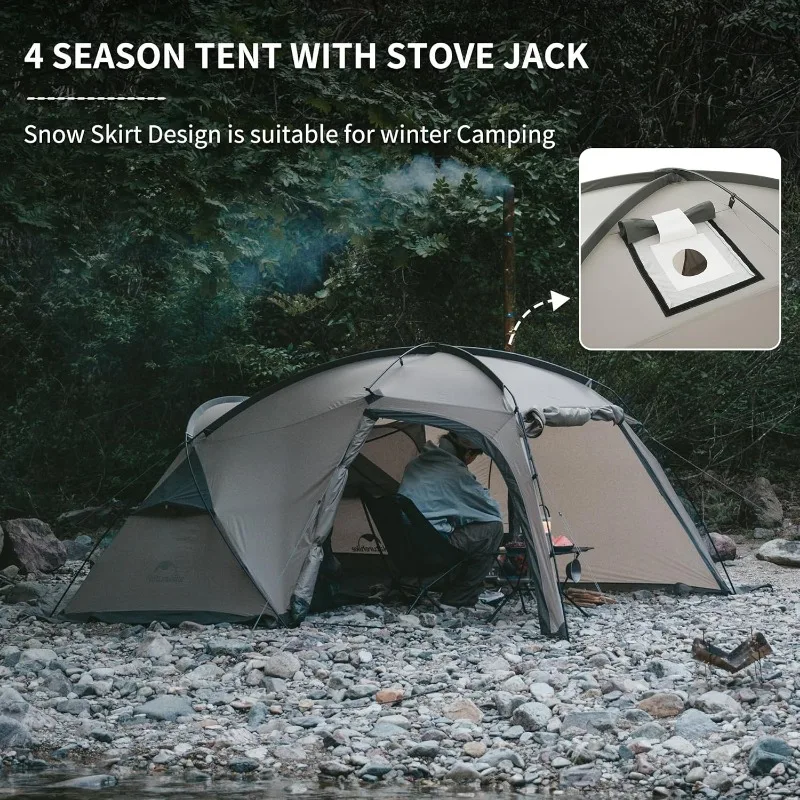
Extended Stay Base Camp Solutions
For those establishing semi-permanent outposts in challenging environments:
| Model Type | Best Features | Weight | Capacity | Price Range |
|---|---|---|---|---|
| Outfitter Wall Tent | 10’×12’ with 5’ walls, aluminum frame | 85-120 lbs | 4-6 person | $$$$-$$$$$ |
| Multi-Room Canvas Lodge | Separated living areas, multiple entryways | 100-150 lbs | 6-8 person | $$$$$+ |
| Canvas Cabin System | Modular components, expandable design | 90-130 lbs | 4-8 person | $$$$-$$$$$ |
These larger shelters emphasize livability for extended periods, with features like standing-height ceilings, multiple rooms, and robust frameworks designed to withstand weeks or months of continuous use. The top-rated heavy-duty canvas tents in this category often include features like reinforced floors and customizable ventilation systems.
Desert and High-UV Environment Options
For scorching environments where sun exposure and temperature extremes are the primary concern:
| Model Type | Best Features | Weight | Capacity | Price Range |
|---|---|---|---|---|
| UV-Protected Safari | Reflective outer treatment, enhanced ventilation | 35-50 lbs | 2-4 person | $$$-$$$$ |
| Desert Expedition | Double-roof design, increased airflow | 40-60 lbs | 3-5 person | $$$$-$$$$$ |
| Heat-Resistant Bell | UV-blocking treatments, adjustable sidewalls | 30-45 lbs | 2-4 person | $$$-$$$$ |
These shelters incorporate maximum ventilation options, UV-resistant treatments, and often feature lighter-colored canvas to reflect solar radiation rather than absorbing it.
For small groups requiring exceptional protection, 4-season winter 2-person tents offer compact yet highly weather-resistant solutions.
Tall / Stand Up Camping Tent, Two Room Camping Tent
$407.93 Select options This product has multiple variants. The options may be chosen on the product pageHeavy Duty 4 Season Tent, Mountaineering Tent, Winter Camping Tent
$870.40 Select options This product has multiple variants. The options may be chosen on the product pageCompact Backpacking Tent, Lightweight Backpacking Tent, Waterproof Camping Tent
$335.52 Select options This product has multiple variants. The options may be chosen on the product pageUltralight Backpacking Tent, Ultralight Dome Tent, Winter Camping Tent
Price range: $369.63 through $370.07 Select options This product has multiple variants. The options may be chosen on the product pageCamping Tent with Vestibule, Waterproof Camping Tent
Price range: $407.89 through $479.48 Select options This product has multiple variants. The options may be chosen on the product pageHeavy Duty 4 Season Tent, Ultralight Freestanding Tent, Winter Camping Tent
$3,722.66 Select options This product has multiple variants. The options may be chosen on the product page
How to Select the Right Canvas Shelter for Your Adventure
Choosing the perfect canvas shelter requires methodically matching your specific adventure parameters with the appropriate shelter characteristics. Follow this systematic approach to ensure you select a canvas shelter that meets your exact needs.
Step 1: Analyze Your Environmental Challenges
Start by honestly assessing the most extreme conditions you’re likely to encounter:
- Temperature range: Record both the lowest and highest temperatures expected
- Precipitation type and volume: Snow load requirements differ dramatically from rain resistance
- Wind exposure: Consider both sustained winds and potential gusts
- Terrain type: Rocky, sandy, or snow-covered ground affects anchoring requirements
- Elevation factors: Higher elevations intensify UV exposure and can create more extreme weather
Step 2: Define Your Usage Parameters
Next, consider the practical aspects of your expedition:
- Group size: Allow 20-25 square feet of floor space per person for comfort
- Duration: Longer stays justify heavier, more feature-rich shelters
- Transportation method: Vehicle-supported trips can accommodate heavier options than backpacking
- Camp setup frequency: If you’ll be moving camp daily, prioritize easier setup designs
- Interior activities: Cooking, gear maintenance, or extended living require more space
Waterproof camping tents come in various configurations, but ensure the waterproofing method is appropriate for your specific environmental challenges.
Step 3: Essential Features Checklist
Based on your analysis, prioritize these features according to your needs:
For Cold Weather:
– Stove jack compatibility
– Snow-load reinforced frame
– Draft-free door design
– Insulated floor options
For Wet Conditions:
– Enhanced waterproofing treatments
– Bathtub floor construction
– Protected ventilation systems
– Strategic rainfly coverage
For High Wind Areas:
– Aerodynamic profile
– Reinforced guy-out points
– Heavy-duty stakes and anchors
– Flexible yet strong frame materials
For Extended Stays:
– Standing height interiors
– Multiple entry/exit points
– Separate sleeping/living areas
– Enhanced ventilation systems
For groups requiring separated spaces, two-room camping tents provide privacy while maintaining the security of a single shelter.
Step 4: Balance Investment Against Requirements
Quality canvas shelters represent a significant investment, but this equation helps determine appropriate spending:
- Calculate your total expected usage days over 5 years
- Divide your budget maximum by these days for a “cost per night”
- Compare this against hotel/lodge alternatives or replacement costs of cheaper tents
- Factor in the resale value of quality canvas (often 40-60% of purchase price after years of use)
The durable tents for all seasons typically offer the best long-term value when matched appropriately to your most demanding conditions.
Step 5: Make Your Final Decision
With your analysis complete, select the shelter that best balances:
– Protection from your most extreme expected conditions
– Comfort appropriate for your trip duration
– Weight/bulk compatible with your transportation method
– Features matching your specific activity requirements
– Value aligned with your long-term outdoor shelter needs
Remember that the right canvas shelter, properly maintained, may be the last tent you ever need to purchase.
Setting Up Your Canvas Shelter for Maximum Protection
Proper setup transforms a quality canvas shelter from merely adequate to exceptional in performance. Following these strategic techniques ensures your shelter will provide maximum protection even in challenging conditions.
Strategic Site Selection
Before unpacking your shelter, carefully evaluate your camping location:
- Natural wind breaks: Position your shelter to take advantage of terrain features, rocks, or vegetation that deflect wind
- Drainage patterns: Avoid depressions where water might pool, even if they seem dry initially
- Overhead hazards: Check for dead branches or other falling hazards before establishing camp
- Sun orientation: In cold weather, position entries to capture morning sun; in hot conditions, seek maximum shade
- Snow considerations: Avoid areas prone to avalanche or wind-loaded snow buildup
The perfect site balances protection with convenience and safety considerations.
Sequential Setup Process for Stability
Follow this tested sequence for maximum stability:
- Clear the footprint area completely of sharp objects that could damage the floor
- Position the shelter with the most aerodynamic profile facing prevailing winds
- Secure corner anchors first to establish the baseline position
- Raise the frame systematically according to manufacturer instructions
- Apply initial tension to the canvas before fully securing all points
- Install all guy lines even if weather is currently mild
- Make progressive adjustments working symmetrically from opposite sides
Expert canvas tent setup techniques emphasize the importance of proper initial tensioning to prevent later adjustments.
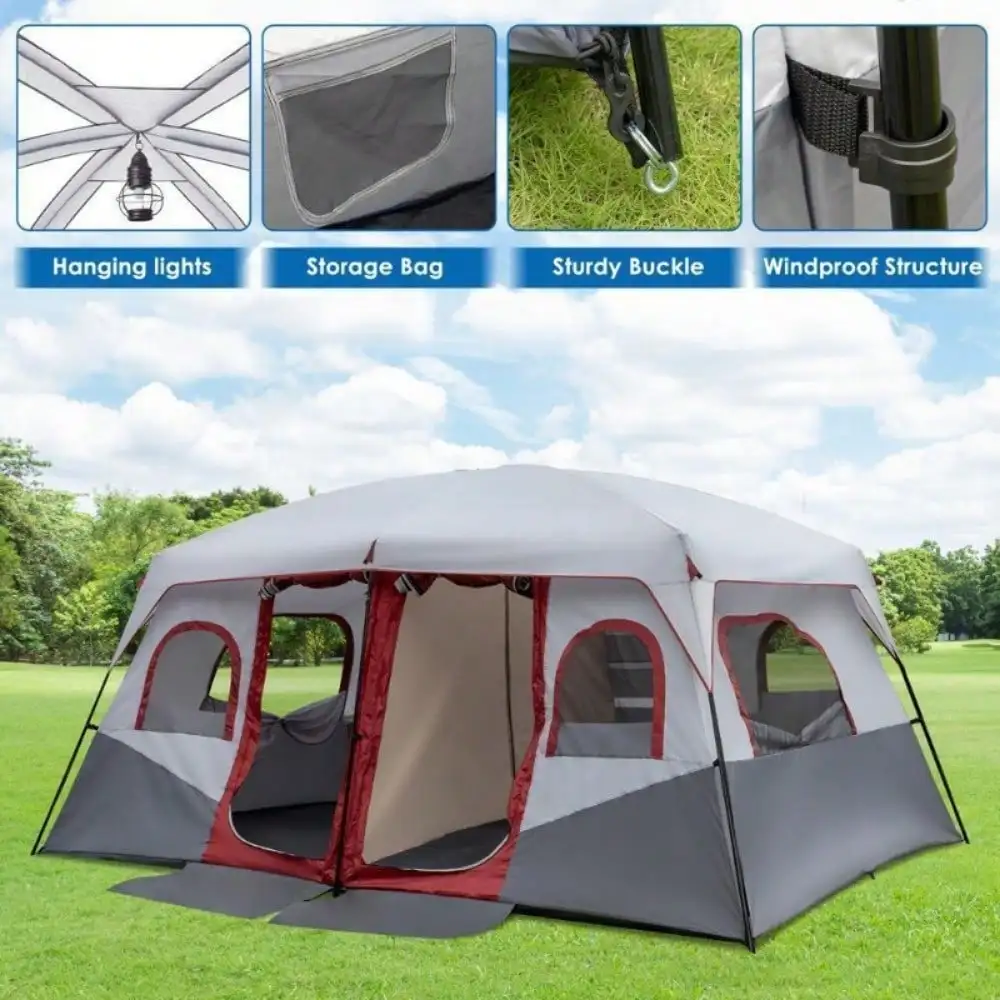
Advanced Anchoring Methods
Different conditions require specialized anchoring approaches:
For Sandy Soil:
– Use broad-based sand stakes at 45° angles facing away from the tent
– Bury deadman anchors (stuff sacks filled with sand) for critical tie points
– Double the number of standard anchoring points
For Rocky Terrain:
– Utilize rock anchors or rock bags where stakes can’t penetrate
– Create tripod structures with rocks to secure guy lines
– Use liquid-filled containers as weights when necessary
For Snow Camping:
– Employ snow stakes, snow flukes, or buried deadman anchors
– Compact snow before placing anchors to prevent loosening
– Create snow walls as additional wind protection
For High Wind Environments:
– Double up on all critical guy lines
– Use trucker’s hitches to create mechanical advantage when tensioning
– Add supplementary internal bracing to critical frame sections
Weather-Specific Adaptations
Modify your setup based on current and anticipated conditions:
- For heavy rain: Adjust guy lines for maximum rainwater runoff, ensure no areas where water can pool
- For snow loading: Add internal support poles, increase exterior guy line tension, clear accumulation regularly
- For extreme heat: Maximize ventilation options, create additional shade with tarps or natural features
- For high winds: Lower profile if possible, add supplementary guy lines, check tensions frequently
For expedition-level protection, instant camping tents with rapid deployment features can be valuable when conditions deteriorate quickly.
Canvas Shelter Maintenance for Longevity in Harsh Conditions
Proper maintenance dramatically extends the life of canvas shelters while ensuring they perform optimally when you need them most. Following these established care procedures protects your investment and enhances reliability in challenging conditions.
Initial Preparation and Break-In
New canvas shelters require specific preparation before facing harsh conditions:
- Weather the canvas: Set up your new shelter in mild conditions and lightly spray with water to initiate the natural fiber swelling process
- Check and seal seams: Apply appropriate seam sealer to all stitched connections
- Test waterproofing: Verify water beads on the surface rather than soaking through
- Tension adjustment: Refine the tension points after the initial break-in as canvas may stretch slightly
- Document baseline condition: Take photos of proper setup for future reference
This initial investment of time significantly enhances long-term performance and helps identify any manufacturing defects before you’re dependent on the shelter.
Field Maintenance During Extended Trips
While in use, regular attention prevents minor issues from becoming major problems:
- Daily inspection: Check guy lines, stakes, and tension points each morning and evening
- Remove debris promptly: Brush off leaves, pine needles, and snow before they can trap moisture against the canvas
- Address small problems immediately: Repair minor tears, loose guy lines, or stake issues before they worsen
- Maintain proper ventilation: Adjust ventilation daily based on conditions to minimize condensation
- Clean mud and organic matter: Prevent mildew by removing soil and plant material from the shelter exterior
Comprehensive guidance on canvas tent care emphasizes prevention over remediation for maintaining optimal performance.
Post-Trip Processing
The steps taken immediately after a trip significantly impact your shelter’s longevity:
- Set up completely dry: Never pack or store canvas with any moisture present
- Clean thoroughly: Remove all dirt, sap, and stains while the material is still set up
- Inspect for damage: Identify any areas requiring repair before next use
- Apply treatments as needed: Refresh water repellency or UV protection if showing signs of wear
- Allow complete air drying: Even when the canvas feels dry, allow additional drying time before storage
Long-Term Storage Protocol
Proper storage between adventures preserves both material integrity and treatments:
- Store loosely packed: Avoid tight folding that creates permanent creases
- Use breathable containers: Canvas-specific storage bags or well-ventilated containers prevent moisture buildup
- Position away from UV exposure: Even indoor light can degrade treatments over time
- Maintain moderate temperature and humidity: Avoid attics, basements, or garages with extreme conditions
- Periodic inspection: Check stored shelters 2-3 times yearly for signs of moisture or pests
For those using their shelters seasonally or for extended periods, additional insights on long-term canvas tent living provide valuable maintenance guidance.
Repair Techniques for Field Issues
Develop these essential repair skills before venturing into remote areas:
- Temporary patch application: Using repair tape or adhesive patches appropriate for canvas
- Seam reinforcement: Emergency stitching techniques using appropriate heavy-duty thread
- Grommet replacement: Field methods for reinforcing torn-out grommets
- Frame repairs: Splinting techniques for damaged poles or supports
- Zipper maintenance: Cleaning and lubricating zippers to prevent failures
Essential Accessories for Enhancing Your Canvas Shelter
The right accessories transform a basic canvas shelter into a comprehensive protection system tailored to specific environmental challenges. These enhancements significantly expand your shelter’s capability in extreme conditions.
Ground Protection Systems
Preserving your shelter’s floor integrity is crucial for long-term performance:
- Heavy-duty groundsheets: Custom-sized, waterproof barriers between your tent floor and the ground
- Insulated floor mats: Closed-cell foam or reflective insulation layers that add R-value and comfort
- Modular flooring systems: Interlocking tiles that create solid, level surfaces in irregular terrain
- Drainage mats: Textured materials that channel moisture away from high-traffic areas
These systems not only protect your investment but significantly enhance comfort during extended stays.
Enhanced Weather Resistance Add-Ons
Additional components that boost protection in extreme conditions:
- Supplementary rainflies: Secondary water barriers that create dead air space for insulation
- Snow skirts: Flexible extensions that prevent drafts and blowing snow entry
- Vestibule expansions: Additional covered space for gear storage and transitional areas
- Wind guy line kits: Reflective, high-tensile cordage with advanced tensioners
For cold-weather adventures, insulated canvas shelters for cold weather camping benefit tremendously from these targeted enhancements.
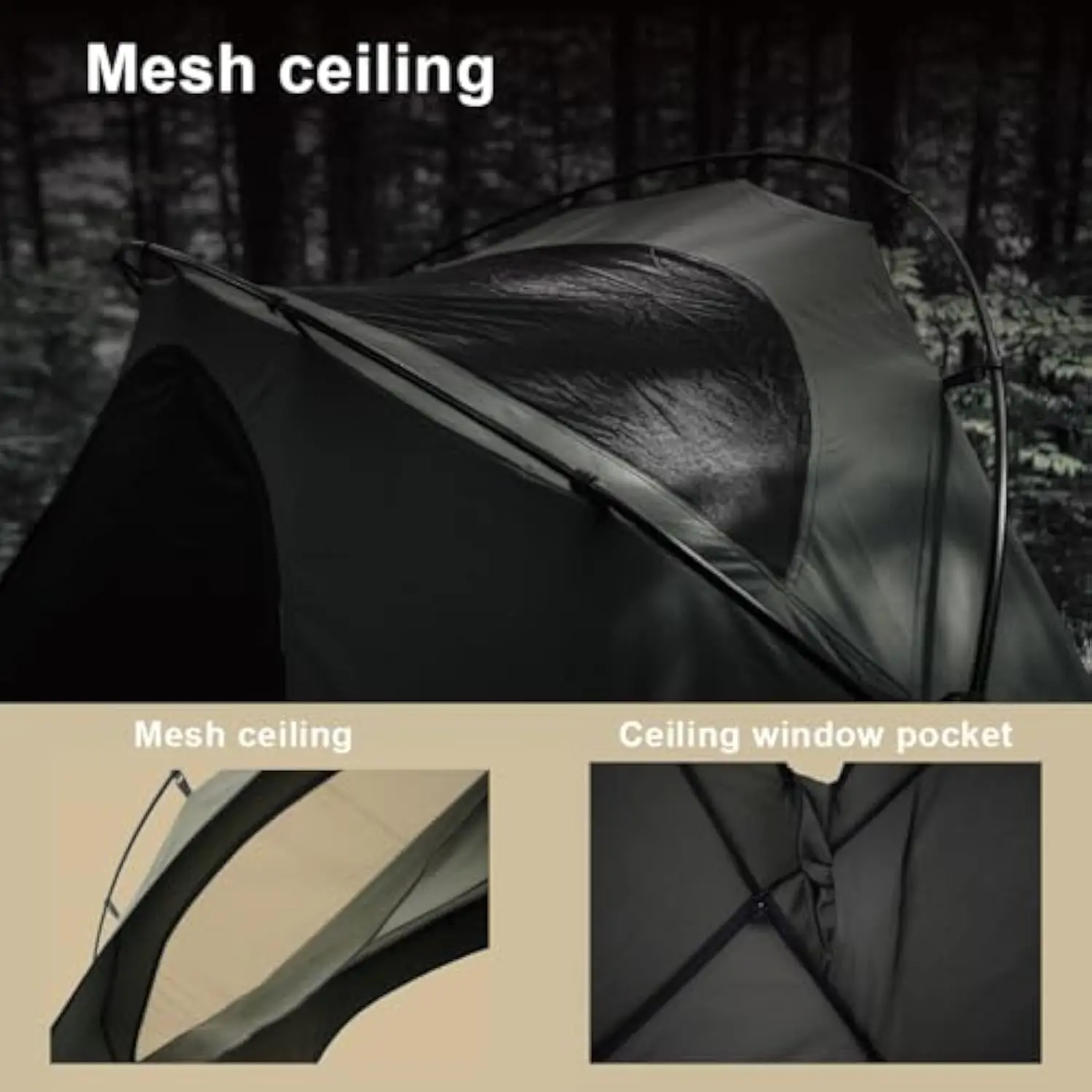
Heating and Climate Control
Managing interior climate dramatically extends the usable range of canvas shelters:
- Tent-safe stoves: Properly sized wood stoves with appropriate heat shields and chimneys
- Carbon monoxide detectors: Essential safety equipment when using any heating system
- Heat-reflective barriers: Metallic films that direct radiant heat back into the shelter
- Ventilation enhancers: Adjustable vents and fans that optimize airflow while maintaining temperature
Remember that any heating system requires proper safety protocols, especially regarding ventilation and fire prevention.
Interior Organization Solutions
Maximizing usable space enhances livability during extended stays:
- Hanging storage systems: Suspended shelves and compartments that utilize vertical space
- Gear hammocks: Overhead storage nets that keep equipment accessible but off the floor
- Modular furniture: Collapsible tables, chairs, and sleeping platforms specifically designed for canvas shelters
- Lighting systems: Canvas-safe illumination options ranging from simple lantern hooks to complete LED setups
These organizational enhancements become increasingly valuable as trip duration increases.
Activity-Specific Additions
Specialized accessories for particular uses:
- Photography stations: Stable platforms for cameras and equipment in challenging conditions
- Portable shower attachments: Privacy sections with water management systems
- Communication centers: Weather-protected areas for radio equipment with antenna passthroughs
- Medical treatment stations: Specialized lighting and clean surfaces for emergency care
Many users of camping tents with vestibules find these additional spaces perfect for customizing with activity-specific features.
What Makes Canvas Shelters Worth the Investment?
Understanding the true value proposition of premium canvas shelters requires looking beyond the initial purchase price to consider long-term performance and return on investment.
Lifetime Cost Analysis
When evaluated over their useful lifespan, canvas shelters often represent superior economic value:
- Expected lifespan: Quality canvas shelters routinely last 15-20 years with proper maintenance, compared to 3-5 years for typical synthetic alternatives
- Replacement frequency: Where a synthetic tent might need replacement 4-5 times over a 20-year period, a single canvas shelter can serve throughout
- Repair versus replace: Canvas shelters can be economically repaired almost indefinitely, while damage to synthetic shelters often necessitates complete replacement
- Resale value: Well-maintained canvas shelters typically retain 40-60% of their purchase price even after years of use
This long-term perspective transforms what initially appears as a premium price into a savvy investment for dedicated outdoor enthusiasts.
Environmental Impact Considerations
Beyond personal economics, canvas shelters offer sustainability benefits:
- Biodegradability: Natural cotton canvas eventually decomposes, unlike petroleum-based synthetics
- Repair culture: The repairability of canvas promotes extended use rather than disposal
- Manufacturing footprint: Cotton production typically requires less energy than synthetic fiber manufacturing
- Lifetime energy balance: The extended useful life distributes the production energy cost over many more years of service
Comfort and Livability Benefits
The qualitative advantages of canvas create significant real-world benefits:
- Temperature stability: Canvas maintains more consistent interior temperatures with less dramatic fluctuations
- Sound insulation: The natural dampening effect reduces wind and rain noise by 40-60% compared to synthetic materials
- Air quality: Enhanced breathability reduces condensation and creates healthier sleeping environments
- Natural feel: Many users report psychological benefits from natural materials versus synthetics
For those spending extensive time in outdoor shelters, these comfort factors translate to tangible improvements in rest quality, stress reduction, and overall expedition enjoyment.
Frequently Asked Questions About Canvas Shelters for Rugged Conditions
How much heavier are canvas shelters compared to synthetic alternatives?
Canvas shelters typically weigh 2-3 times more than their synthetic counterparts of similar size. A two-person synthetic backpacking tent might weigh 4-5 pounds, while a comparable canvas shelter would weigh 10-15 pounds. This weight difference comes with significant durability and comfort benefits but makes canvas better suited for base camping or vehicle-supported adventures rather than long-distance backpacking.
Does canvas really perform better than modern synthetic materials in extreme weather?
Yes, in specific ways. Canvas excels in insulation value, condensation management, durability against abrasion, and resistance to UV degradation. Modern synthetics offer advantages in absolute weight, initial water resistance without treatment, and immediate setup stability. The ideal choice depends on your specific environmental challenges and trip parameters.
How difficult is it to repair canvas shelters in the field?
Canvas is among the easiest shelter materials to field-repair. Simple tears can be sewn with basic needle and thread or patched with canvas repair tape. Most repairs require minimal specialized skills and can be performed with multi-tools or basic repair kits. This repairability is a significant advantage in remote locations where replacement isn’t an option.
Are canvas shelters completely waterproof?
Properly treated and maintained canvas is highly water-resistant but works differently than synthetic waterproofing. Canvas fibers swell when wet, creating a naturally water-resistant barrier. Most quality canvas shelters require a “weathering” process where they get lightly wet, allowing the fibers to swell and tighten before facing heavy precipitation. After this process, they provide excellent water protection when properly tensioned.
How do you prevent mold and mildew in canvas shelters?
Prevention is key: always dry your canvas completely before storage, treat with appropriate anti-mildew products, ensure adequate ventilation during use, and address any organic material (leaves, soil) promptly. If mildew does develop, a solution of white vinegar and water (1:5 ratio) can be effective for cleaning, followed by complete drying and retreatment.
Can canvas shelters be used in winter conditions?
Canvas is excellent for winter camping when properly designed for snow loads. Many canvas shelters include stove jacks for safe heating with small wood stoves, making them superior to most synthetic options for cold-weather comfort. Their natural insulation properties and compatibility with internal heating make them preferred choices for extended winter expeditions and hunting camps.
The exceptional durability and versatility of canvas have made these shelters a preferred choice for those who venture into truly challenging environments where shelter reliability becomes a critical safety consideration rather than merely a comfort preference.

